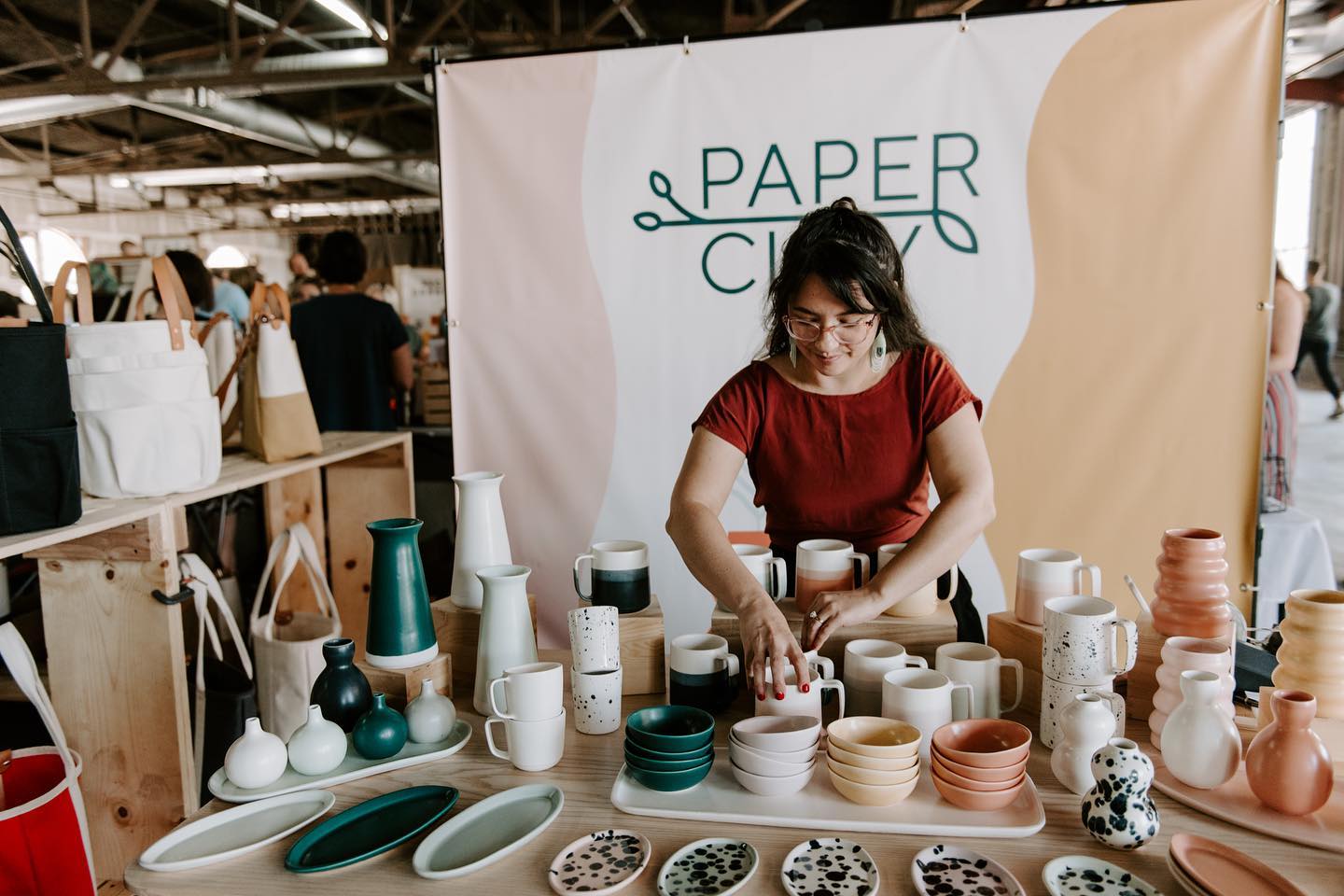
In 2015, Al and Mike Barker founded Made Market with the goal of coming alongside the maker community and supporting their small businesses, providing a platform and an elevated visibility from which to share their work. Here, they share their top tips for attracting and supporting your vendors.

Things are changing in the world of in-person markets, and it started well before 2020. In times past, handmade markets were dominated by hobbyist vendors and low-quality products.
Makers are trending younger thanks in large part to the expansion of the gig economy which has in turn inspired many to be their own boss and live lifestyles that in some cases, take them all over the U.S.
Market organizers can no longer simply adopt the Field of Dreams mantra: “If you build it, they will come.” In this new reality, compassion is key. If you want to consistently attract the very best vendors to your market, consider implementing the following strategies.
1. Know Your Primary Customer
As a market organizers you always have 2 sets of customers to keep in mind: vendors and shoppers. Of course you need to figure out how to attract both groups, keep them engaged, and bring them back consistently. But have you considered which group is your primary customer? It may be tempting to either treat them both equally or even lean hard into getting as many shoppers through the doors as possible. If you’ve ever struggled with this question without resolution—or if you’ve never considered it at all—let me offer you some potentially helpful clarity. Your primary customers are your vendors. They must be your first and foremost consideration at every turn. We start here because it sets us on a trajectory so that the rest of the tips actually make sense.
Some of you are thinking “Well, this is obvious. Our main source of income is booth fees. Clearly we should consider vendors our primary customers.” You’re right, and thank you for making my point even stronger! The reason we start here is that some organizers haven’t considered this before. And those who have already come to this conclusion tend to switch gears after all booth fees are paid. They cater certain aspects to makers, but as the market draws near, they may start considering shoppers wants more than they should. Do you want shoppers to show up en masse and enjoy themselves? (Rhetorical question alert 🚨) Of course you do! But your first responsibility is to your people, your squad: your vendors.
2. Set Up for Success: Curate The Shopping Experience
This next sentence may sound a little crazy—especially with a blog post with the word “compassion” in the title—but it’s so important: Not every vendor belongs at your upcoming market. At some point pretty early on, you need to start getting comfortable with setting some limits on who can come sell at your events. There are a number of good reasons that go into this—and we’ll talk about a few below, but it all adds up to the fact that you want to put the right vendors in front of the right shoppers so that sales are maximized.
Shoppers have become accustomed to walking leisurely past most booths at any given market. They browse for 30-40 minutes and then circle back to the few booths that sparked their interest. It’s sad, but they take it for granted that most booths/items won’t appeal to them. It’s your job as an organizer to reject this paradigm and create a space where shoppers will be able to find something they love at every booth. After a few markets, your reputation and attendance will grow quickly. This isn’t only gratifying for you, it’s exactly what you sold to your vendors when you asked them to put their trust in you.
You can’t think of this as rejecting people or picking winners and losers. You owe it to your vendors to put them in a place to succeed. You likely know your shopper profile well, so you have some sense of what will sell and what won’t at your market. If you start accepting vendors that you’re worried won’t sell, you’re not setting them up for success. Early on, we weren’t thinking this way and accepted a few vendors that we had genuine concern about. Many of them didn’t sell very well. We had that instinct, but we didn’t listen to it! If you’re able to be discerning on the front end, you can avoid disappointments all around.
For people pleasers—which seems to describe a lot of us that go into hospitality industries—this can be really tough. If you’re someone who enjoys making people happy, you’re just going to have to press through on this one. Your final product will be exceptionally gratifying, and your vendors and shoppers will agree.
Bonus tip #1: Exclusivity goes a long way to attracting excellence in both vendors and shoppers.

3. Communication is 🔑
Back in 2018, we had a major wrench thrown into our Holiday Market. The 15000 square foot room that we had paid to rent ended up being under construction. The only alternative that was remotely large enough was an upstairs room that literally looked like the zombie apocalypse had just come and gone. The heating was marginally working, and the only access for the makers to load in was an old freight elevator! We put as positive a spin on it as we could, but we wanted to make sure that our vendors were prepared so we let them know exactly what to expect. We ended up getting fantastic feedback on our post-market surveys. Most vendors mentioned the difficulty of the room, but it was mentioned almost in passing. We had all lived it together, and they had been ready for it to be less than ideal.
What’s your plan for your vendors? What processes do you have to get them from signing up to the day when you finally meet them at your market? What are your expectations of them? What should they expect for load-in and load-out? What happens if a vendor can’t make it to your market after paying the booth fee? These are likely all questions you’ve received. It’s your responsibility to make sure you clearly communicate all expectations and changes that may arise.
If you’ve never thought through all of these details, it would hugely benefit you to take some time and consider your vendor journey. Start with answering the questions above and let them be a catalyst to help map every twist and turn your vendors will go through. Decide which moments they will be best served by an email reminder. And PLEASE take some time to create a vendor agreement that you can update before each market with new details. This will set all expectations beforehand and protect you if things don’t go exactly as hoped.
4. Fans Over Supporters
I have very little interest in bringing in shoppers who like to “support handmade.” I’m exceptionally interested in shoppers who are enthusiastic fans of handmade vendors! There’s a difference here, and it’s important. Sometimes market organizers can be tempted try to gather shoppers by talking about the importance of “supporting makers” or “shopping small.” These are great ideas to get behind, but even if it works, it can’t yield long-term results. And in a worst-case scenario, it can almost come off as a guilt-trip move: “You don’t really care about handmade craftsmanship unless you come to our market.” That’s the last message we want to send.
Instead, what if you could help your vendors gain fans that follow them on social media after the market is over, order from their online stores and tell all their friends about them? That would be of lasting value, and your contribution won’t be lost on your vendors. How do you go about adjusting your messaging and emphasis? It leads nicely into our next tip because you start by treating your vendors like the stars of the show they are.
5. Your Vendors are the Stars 🌟
It’s easy to start feeling pretty good about your market and brand when you start seeing multiple thousands of shoppers show up to shop. Sure, you worked hard to gather these folks! You did whatever it took to get them through the door. Do whatever it takes to keep yourself from thinking that all of these people came for you. They came for your vendors! Whatever level of notoriety your brand has achieved, it’s been on the coattails of the many vendors who trusted you enough to participate in your market. Without them, there is no market. Your vendors are the stars of the whole show.
Every social media interaction or blog post should highlight your vendors. Call them artists, artisans, makers, and entrepreneurs. Get inspired by them and talk about why you’re excited by them. Make it your ambition to deflect any praise onto them. Consider highlighting each maker on your social media feeds once before each market. Keeping them in their rightful place as stars of the show not only builds them up (which you can’t help but love in itself), it also will almost immediately elevate your brand. Humility is an exceptionally attractive quality, especially in a hospitality-driven business.
Bonus tip #2: Vendor Perks! Partner with exceptional companies—like our friends at noissue—to provide some bonus gifts and/or opportunities for your vendors. For the past few years, we’ve had the opportunity to host giveaways, provide discount codes, and hand out samples through various connections we’ve made in the industry. Reach out to these guys. They’re eager to work with you!

6. Over the Top Hospitality
Ooooh this one is fun! If your vendors are the stars of the show, then we need to treat them like it! When the day of your even finally arrives, it’s easy to get caught up in various tiny crises that always seem to show up at a live event. Even as you take care of the minutiae, don’t lose track of your makers. Your efforts don’t need to be overly difficult or costly; they only must be sincere and timely.
This starts when a vendor first shows up to set their booth up. This moment can set the tone for the entire market. Be there to greet them and show them where to go. Then if you’re able, you can ask if they need any help carrying a few things in. Depending on the size of your venue, you may need some staff/volunteers that can help. That’s totally fine! Only make sure that your staff understands how hospitable you want them to be.
Stock your maker green room really well. If you’re not familiar with what a “green room” is, it’s the place backstage at a concert where the VIP’s can go to find food or beverage and a little peace and quiet for a moment. If at all possible, create a space like this for your makers. Include different snacks and drinks. A few years ago, we started offering a PB&J bar. We added all sorts of nut and seed butters, and it’s been a huge hit. It wasn’t professional catering, but it communicated to the makers that we cared in ways that were unique and unexpected.
Make a personal connection with every maker you can. One of my favorite things to do—usually two times each day—is to personally walk around and hand bottled water out. It’s a great opportunity to check in and have short conversations with vendors. This one small act of kindness is regularly a highlight on our vendor surveys.
7. Limit Shopper Distractions
This is pretty straight-forward, but you want to get rid of anything that could take away from your vendors. Cut out any and all distractions. We would recommend eliminating things like live music and cash bars. These types of things can draw spectators and may even act to repel otherwise motivated shoppers. There’s nothing wrong with wanting the shoppers to enjoy themselves, you just need to go about it in a subtle way. Make your own playlist of fun, energetic songs. Invite a local brewery and food trucks. These are great things that can enrich the market experience as long as they don’t distract from the vendors.
8. Vendor Surveys
If you’re not sending surveys to your makers after every market, you’re missing out on an incredible source of potential improvement for your business and event. Consider your questions carefully. You’re trying to find out, “What don’t I know yet?” In general you’ll want to ask clear, unbiased questions. The exact questions can vary , but one must-ask question is “Would you recommend this market to other vendors you know, and why?” It’s not just about what their impression was. It forces the vendor to consider how another person might experience your market. Remember that any feedback is good feedback. Some comments or ratings may be painful, but pain has an incredible capacity to encourage growth and betterment. And consider requiring name and email address on the survey. If you need to follow up to repair a relationship, it’s really convenient.
Bonus tip #3: If you word a question seeking positive feedback just right, you’ll get some incredible answers that can double as testimonials that you can publish on your website.
9. It All Comes Down to One Thing: Compassion
My hope is that this article would resonate with you. You’ve been in the trenches. You know the difficulties and joys that come with organizing, promoting, and executing an elaborate event and working with dozens—if not hundreds—of people. You’re already doing it! I love the idea that we might be able to come alongside some of you, shine light on a slightly different perspective, and encourage you to get on with the work that you love to do.
If you get one over-arching take away from this post, make it this: Consider how you might gain compassion for your vendors. Listen their stories. Ask about their families and aspirations. As you get to know them better, you start to gain a perspective for where each one comes from. Let that motivate you as you make decisions and maybe some changes to your market. As a market organizer, you have the opportunity to work alongside a vibrant community that already existed before you came along. Work hard to join in their struggle and to become one of their advocates and biggest fans in the wider world.

Keep up with @mademarket on Instagram and check out upcoming events on their website!
